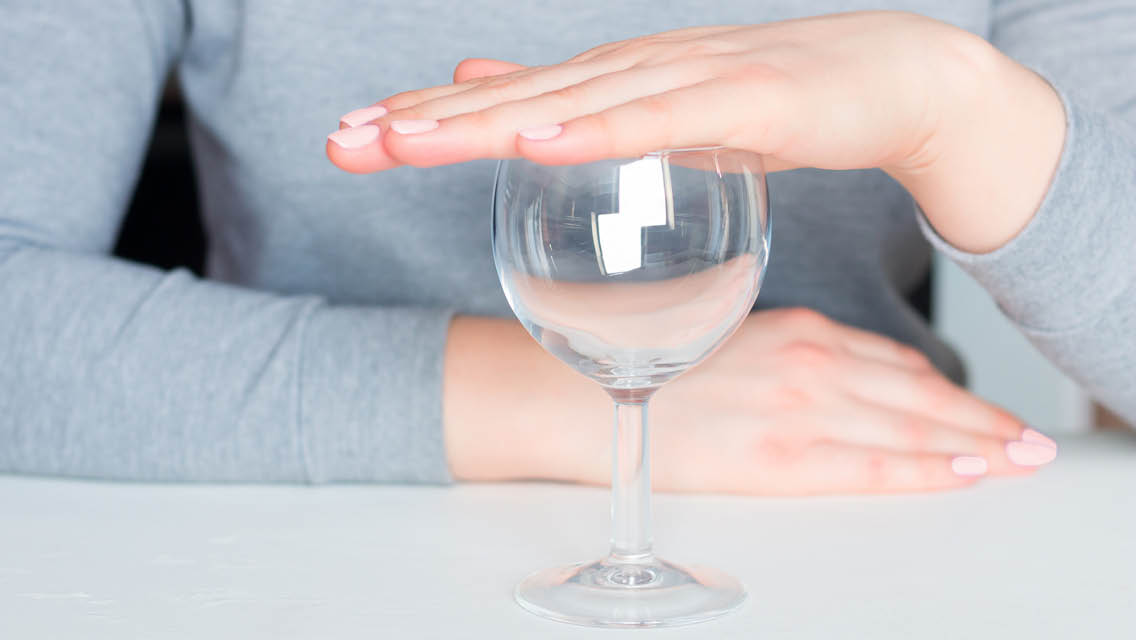Navigate to the following sections:
• What Are the Benefits of Drinking?
• How Does the Body Process Alcohol?
• Why Do We Each Handle Alcohol Differently?
• How Does Tolerance Change as We Age?
• How Do Hormones Influence Tolerance?
• What Is Moderation?
• Can Drinking Aid Digestion?
• How Do Different Alcohols Affect Us?
Few pleasures rival the sharing of good food and drink with dear friends. From raising a toast at the outset of a meal to lingering over dessert with a digestif, alcohol can add fun, pleasure, and ceremony to social gatherings.
“Animals feed, but humans tend to eat and build a culture around it,” says nutrition-psychology educator Marc David, MA. “Lingering and socializing over a meal gives us a chance to celebrate food and drink, a chance to get to be human.”
Still, the health effects of drinking alcohol are hotly debated. A January 2025 advisory from then–U.S. Surgeon General Vivek Murthy notes that consuming alcohol increases the risk for at least seven types of cancer.
Conversely, a 2024 meta-analysis from the National Academies of Sciences, Engineering, and Medicine concluded that moderate drinking (defined as two drinks or fewer in a day for men and no more than one drink in a day for women) is associated with lower all-cause mortality.
Alcohol-consumption guidelines reflect these contradictions: In the early 2000s, many health authorities suggested that moderate consumption of red wine might offer certain health benefits, such as improved cardiovascular health. But in 2022, the World Heart Federation took the position that no level of alcohol consumption is safe for heart health.
It can all be a bit bewildering, to say the least.
While most of us know that drinking to excess isn’t in anyone’s best interest, and that addiction issues are a separate category, one might still wonder what’s up with occasional social imbibing. So we talked to some experts, and this is what we learned.
What Are the Benefits of Drinking?
Many cultural traditions feature moderate drinking. Four of the five Blue Zones — cultures around the world with the longest-lived populations — include modest social drinking as part of their routines. (The exception is Loma Linda, Calif., a Blue Zone with a large population of Seventh-day Adventists.)
The jury is out on whether alcohol itself contributes to longevity, but many experts believe modest drinking can facilitate stronger social networks. Those do sustain us.
“Research shows that people who drink socially … tend to have more friends and so more emotional support, a key source of mental health,” writes neuropsychopharmacologist David Nutt, DM, in Drink? The New Science of Alcohol and Your Health. “They also feel more contented and more involved in their local community.”
“Lingering and socializing over a meal gives us a chance to celebrate food and drink, a chance to get to be human.
In a 2012 study, psychologists filmed groups of three people getting to know each other. Some groups drank alcohol, some a placebo, and some a control beverage. The members of the mildly intoxicated group reported more feelings of closeness in their interactions and displayed more genuine smiles than those in the other two groups.
Beer and wine may also offer some modest health benefits. Red wine contains resveratrol, a polyphenol in red grapes that’s beneficial for the heart. Functional nutritionist Jesse Haas, CNS, LN, notes that the silicon and hops in beer may protect brain cells and slow neurological disorders, such as Alzheimer’s.
“Beer can be a source of magnesium, calcium, and phytoestrogens that are beneficial for hormonal balance,” adds Haas.
Marc David notes that alcohol’s relaxing effects are also supportive. “Alcohol stimulates the mental and emotional but also the physiologic relaxation response,” he says. “That’s where we’re designed to do our most optimal digestion, assimilation, and natural appetite regulation.”
How Does the Body Process Alcohol?
Here’s what happens under the hood after that cold beer or celebratory margarita. First, the alcohol is absorbed through the walls of the stomach and small intestine. The bloodstream carries it to the liver, where an enzyme called alcohol dehydrogenase starts to break it down, producing a byproduct called acetaldehyde. (An excess of this chemical compound is the culprit behind hangovers.)
The alcohol and acetaldehyde mixture travels from the liver to the heart and crosses the blood-brain barrier to enter the brain. This gives you a buzz, usually within 10 or 15 minutes of your first sip. Your blood vessels start to expand, possibly making you feel warmer and a little flushed.
Alcohol then activates the calming GABA (gamma aminobutyric acid) system in the brain, which relaxes you and lowers your inhibitions; it also stimulates the release of the feel-good neurotransmitters serotonin and dopamine as well as endorphins, your body’s natural opioids. These chemical rewards all contribute to alcohol’s de-stressing effects — as well as to its addictive allure.
Why Do We Each Handle Alcohol Differently?
Have you ever wondered why you seem to tolerate alcohol so differently than your Uncle Bill, who spills all his secrets after two sips of beer? Or your Aunt Beth, who can drink the entire family under the table? Several factors influence how we process alcohol, including age, sex, genetics, body composition, and hormonal fluctuations.
“How we detoxify is different from person to person,” notes functional-medicine practitioner Marcelle Pick, OB-GYN, NP.
“Alcohol doesn’t absorb into fat, so it ends up being in the blood longer and at higher concentrations.”
In general, male bodies tend to tolerate alcohol better than female ones, due in part to their larger size but also because of differences in body composition, including water (which dilutes alcohol) and fat. “People with ovaries have higher body fat than people with testes,” explains Haas. “Alcohol doesn’t absorb into fat, so it ends up being in the blood longer and at higher concentrations.”
Women also have lower levels of alcohol dehydrogenase, the enzyme that breaks down alcohol in the liver. And roughly a third to half of people of Asian descent possess a genetic variant that lowers levels of this enzyme, which means they don’t break down alcohol as efficiently and may be more likely to become flushed and nauseated from drinking.
How Does Tolerance Change as We Age?
When we’re in our 20s, enthusiastic social drinking might fit seamlessly alongside fitness routines, jobs, and other obligations. A couple of decades later, the same approach to alcohol might tank our functioning.
That’s because as we age, we process alcohol less efficiently. “Some are surprised by it and find they feel intoxicated by the same amount of alcohol they used to drink [without a problem],” says Pick. But as we get older, we have less muscle mass and body water, she explains, which affects alcohol processing.
The liver’s capacity to break down alcohol decreases with time. Think of a bathtub. When the drain is open, the tub empties easily. As we move on in years, the liver’s drain tends to slow down. “One hypothesis is there’s less blood flow to the liver as we age,” says Haas. “If blood is flowing to the liver at a lower rate, then that drain is also slower.”
There’s also the simple fact that the longer we live, the greater our exposure to various toxins — and the greater their cumulative burden on the liver.
“The more you’re hanging on to those toxins, the more the drain is clogged and metabolism is slowed down,” cautions Haas. “It’s important for everyone to cultivate a detox-supportive diet and lifestyle, and keeping alcohol consumption moderate is important for that. The less effectively those detox pathways function, the more likely we are to experience disease as we age.”
How Do Hormones Influence Tolerance?
As with age, hormones can influence how we process alcohol. Higher estrogen levels, for example, slow alcohol metabolism. For women, that means tolerance is generally highest around menstruation, when estrogen levels drop, and lowest around ovulation, when estrogen is high. (Other factors can also play a role: Overall hydration, for instance, can dip during menstruation, decreasing tolerance.)
In general, excess alcohol consumption increases the production of estrogen and decreases the ways it’s metabolized, says Pick. “There are different pathways where estrogen is metabolized, and some pathways increase the risk of breast cancer. That may be one reason there’s an association between regular alcohol consumption and breast cancer.”
People with uterine fibroids, endometriosis, or PMS symptoms may want to be especially careful to moderate their consumption, says Haas. “PMS symptoms like breast tenderness or night sweats are indicative of an estrogen imbalance.”
Alcohol may exacerbate perimenopause symptoms, too, in part because it increases noradrenaline, which contributes to hot flashes. It can also lower testosterone by increasing levels of the enzyme that breaks it down.
What Is Moderation?
Everyone’s tolerance is different, so the question of moderation can be tricky.
Like the National Academies, the Centers for Disease Control and Prevention defines moderate drinking as no more than two drinks in a day for men and one per day for women. Functional-medicine physician Elizabeth Boham, MD, MS, RD, encourages men to aim for 10 or fewer drinks per week; women for five or fewer. “It’s healthier not to concentrate those drinks into one or two days but to spread them out.”
If you’re regularly drinking more than this, she suggests, look for the underlying reason. Is it to relax? To socialize? Or has drinking simply become a habit?
“Once you figure out what’s driving it, you can find other ways to meet those needs,” she says. Going for a walk or hitting a yoga class can be a great way to relax and transition after work. If it’s the ritual you miss, try swapping in sparkling water or a mocktail. (Looking for alcohol-free alternatives? Try one of the recipes at “Summer Mocktails” or cozy up with one of these “11 Winter Mocktails.”)
Finally, if you pay closer attention to how drinking makes you feel, it may become easier to notice — and switch to water — when you’re overdoing it.
“Alcohol, like caffeine and sugar, is a powerful substance,” says David. “With any powerful substance, it’s always about the dose. You want to come to that substance with a healthy respect and understand, I can get a great benefit from this if I can hit the sweet spot, where I get what I’m looking for without stepping over the line.”
Can Drinking Aid Digestion?
It certainly can. Digestifs such as aquavit, amaro, and brandy are made with herbs and spices containing potent digestive benefits. “These can be quite intense in their taste and herbal profile,” says David. They help stimulate digestive enzymes after a big meal, ushering the contents of the stomach along the GI tract. (For an alcohol-free recipe, try this “Fennel-Ginger Digestif.”)
Historically, alcohol was sometimes used to protect the gut against parasites; fermenting grains was a way to create drinkable beverages in the absence of clean water. And Haas notes that vermouth is made with wormwood, which is antiparasitic.
Still, alcohol’s most important contribution to digestion is stimulating the relaxation response, critical for our ability to digest and assimilate nutrients from food.
“Anything that helps us move out of the stress response makes us more open to pleasure,” says David, noting that the stress hormone cortisol naturally blunts our pleasure receptors. “If you eat a dessert when you’re stressed, you’ll have to eat more cake or ice cream to get the same amount of pleasure.”
By catalyzing the relaxation response, enjoying a drink at the beginning of a meal can help attune us to the pleasure of eating, which helps enhance our digestion.
How Do Different Alcohols Affect Us?
Though many of us feel that certain alcohols affect us differently (it seems like red wine disturbs our sleep, or that tequila makes us euphoric), there’s little science to explain why this may be so. “From a chemical standpoint, there’s no difference from one alcohol to another — though there may be a difference in other compounds in the beverage,” says Haas.
Brown liquors, such as brandy and bourbon, as well as darker beer and red wine, do tend to have more congeners — complex alcohols formed in the aging process that are associated with worse hangovers and possibly greater intoxication.
And if gluten gives you trouble, so will gluten-containing beverages, such as beer or rye whiskey. As for tequila’s reputation as a “clean” spirit, it is grain-free and made from agave, and it doesn’t spike blood sugar as much as some other liquors. This may account for why some people feel less of a negative impact after drinking it.
The way alcohols are processed also has an effect. “There are toxins and pesticides in alcohol that can impact how much stress it puts on the body’s detox system,” notes Boham. Opting for organic or biodynamic wines can minimize the toxic load.
As with most things, you’ll have to experiment to find which alcoholic beverages, if any, feel right for you. “If you want to occasionally have a drink, experiment to see what’s less problematic for you,” advises Pick.
And then savor it — ideally in wonderful company.
The Problem of Excess
If you’re not at risk for alcohol addiction and are able to drink socially, consuming alcohol occasionally and modestly may have real benefits. Consuming it in excess, however, can lead to multiple health problems.
According to the Centers for Disease Control and Prevention, excessive alcohol use can put you at risk for high blood pressure, heart disease, digestive problems, cancer, weakening of the immune system, dementia, depression, and alcohol dependence. These risks from drinking alcohol are not linear but exponential, meaning they don’t just increase with more drinking — they worsen.
Still, scaling back can make a big impact. “If you drink a high amount, cutting down will reduce your risk of harm much more than if you are reducing from a low level,” explains David Nutt, DM, in his book Drink? The New Science of Alcohol and Your Health.
Reducing frequency and taking routine breaks from alcohol can also make a difference. Elizabeth Boham, MD, MS, RD, notes that 90 percent of people who have two or more drinks a day are at risk for fatty liver, a condition in which sugars from alcohol are stored in the liver as fat. (Fatty liver has also been linked with insulin resistance and type 2 diabetes.)
But stopping alcohol consumption, even just for a couple of weeks, can start to reverse the condition. (For more on fatty liver, see “The Hidden Liver Crisis.”)
The Shift to THC Drinks
Many people are turning to THC drinks as an alcohol alternative. These consumers often aren’t seeking to avoid intoxication so much as to find a way to relax without risking alcohol’s more unwelcome effects.
Dana Thompson, founder and CEO of Heti, a Minnesota-based THC beverage brand, is one of those people. She finds the relaxing effects of a low-dose THC and CBD beverage to be a welcome replacement for alcohol. While alcohol can be stress relieving in the moment, it can also have a backlash effect, leading to “hangxiety” — heightened anxiety once alcohol leaves the system. (Ever wake up with a racing mind at 3 a.m. following a night of drinking?)
“We all love to celebrate,” says Thompson. “It’s nice to have something that we can enjoy at the end of the day or bring with us to a party that’s different from alcohol. It’s a way to take the edge off. It drops our shoulders and makes us feel good.”
Still, the effects of THC are highly individual. Some find it helps ease anxiety, while others find it provokes anxiety. For many, the effects depend on the dose. Doses on the lower end, particularly when combined with CBD, are more likely to promote relaxation without triggering paranoia.
If you haven’t seen THC beverages in your area yet, you may soon. The regulatory landscape is evolving. Some states allow THC beverages to be sold in retail outlets, while others still ban the sale of THC in all forms.
The U.S. Food and Drug Administration and state regulatory agencies are under growing pressure to establish guidelines for its sale and use, particularly concerning product safety, marketing, and age restrictions.
If you’re curious to try a THC beverage, it’s wise to start with a low-dose variety, containing no more than 3 milligrams of THC. And look for brands that avoid food dyes and excessive sugar.
This article originally appeared as “A Toast to Moderation” in the September/October 2025 issue of Experience Life.





This Post Has 0 Comments